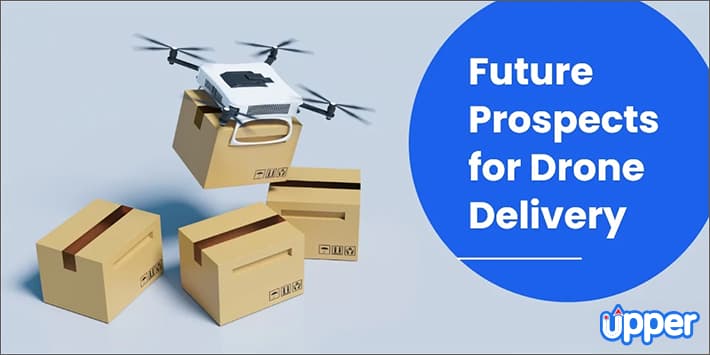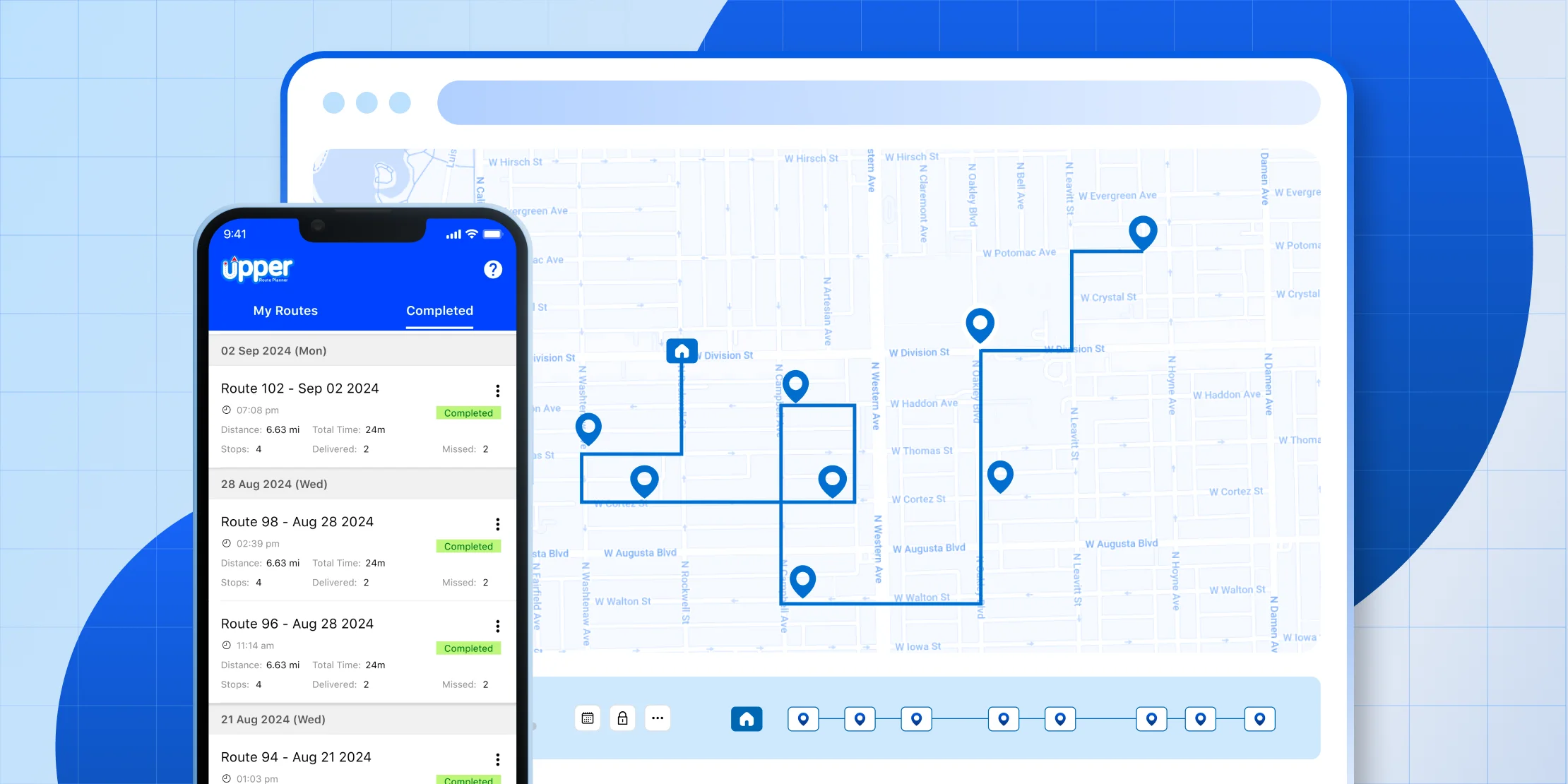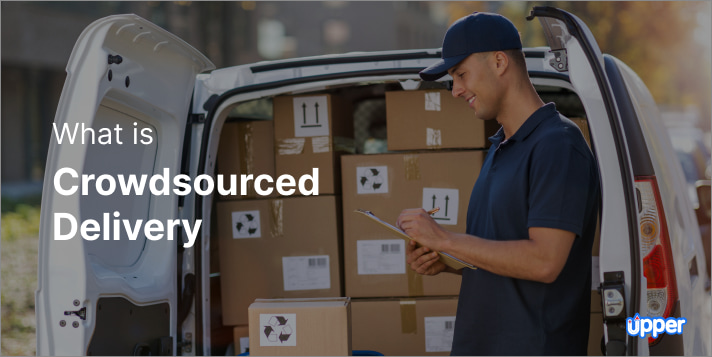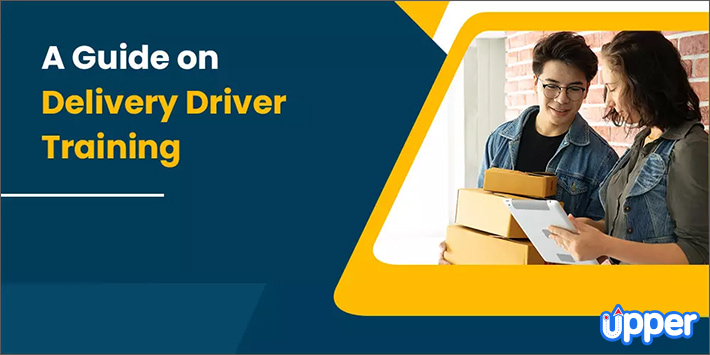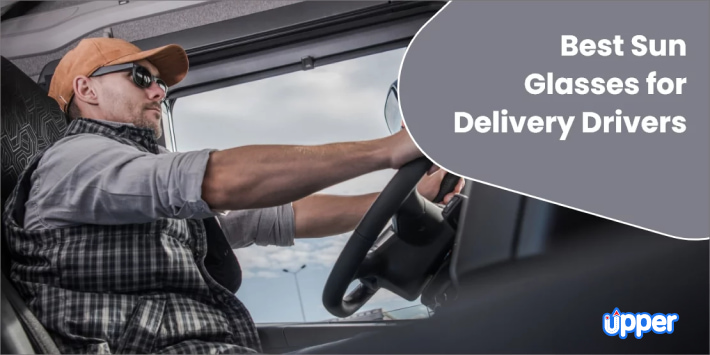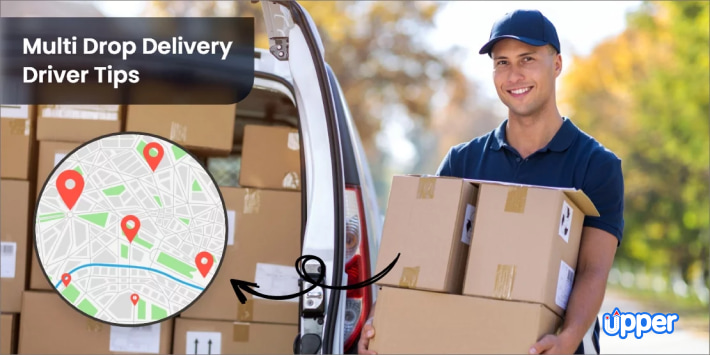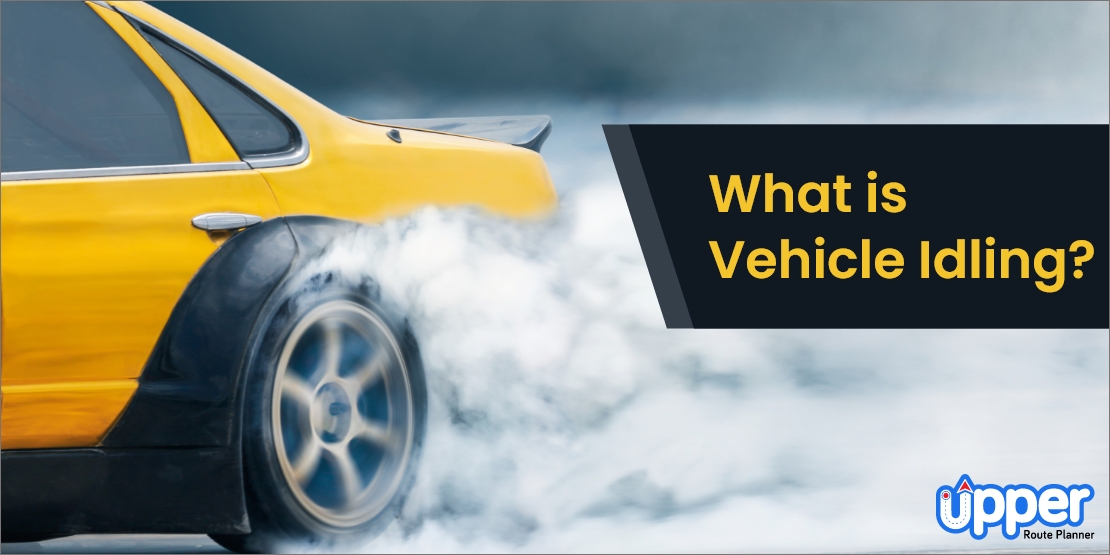The modern-day delivery market demands a drone delivery guide for it believes that drone deliveries are the future. The concept of unmanned aerial vehicles has been around for some time with the earliest iteration being used in Venice by Austrian forces in 1849.
Though the earliest attempt at drones wasn’t anything to ride home about, the latest drones are capable of flying as fast as cars and going farther than ever before. This makes many people wonder if drone deliveries are a viable alternative to traditional deliveries.
While drone delivery has already caught some wind, it is still unclear what the future holds for the field. Since this looks like quite a lucrative opportunity, many businesses have been looking for a drone delivery guide.
Forget Spaghetti Routes, Optimize Routes for Your Entire Team with Upper
Start a 7-Day Free Trial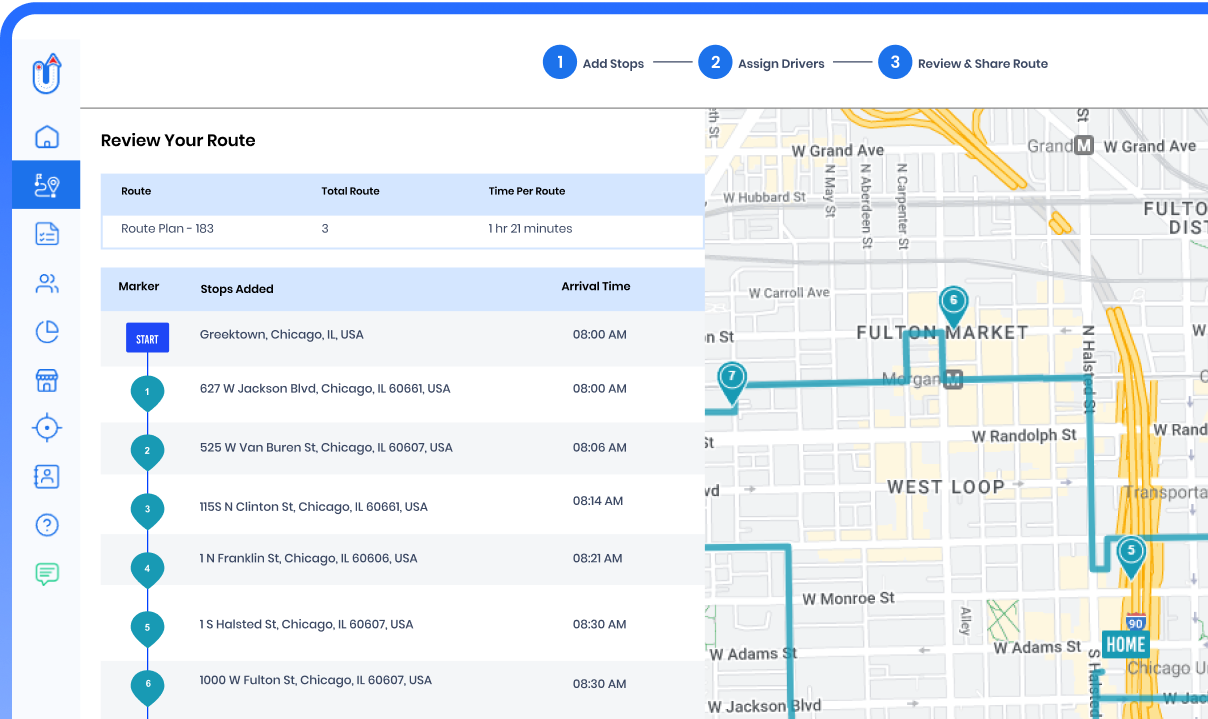
Table of Contents
- What is Drone Delivery: A Complete Overview
- The Business Case for Drone Deliveries
- Technical Requirements and Implementation
- Regulatory Compliance and Legal Considerations
- Cost Analysis & ROI Projections
- Operating a Drone Delivery Company
- Future Trends and Industry Outlook
- Why are Drone Deliveries Significant?
- Pros and Cons of Drone Delivery Services
- Alternative Solutions to Drone Delivery
- Perform Unlimited Multi-stop Deliveries Using Upper
- FAQs
- Future Prospects for Drone Deliveries
What is Drone Delivery: A Complete Overview
Drone delivery is the process of using small or medium-sized unmanned aerial vehicles (UAVs or popularly known as drones) to deliver packages from retailers to customers, similar to traditional mail or courier services. These drones are remotely regulated and autonomous while maintaining a consistent speed.
The Business Case for Drone Deliveries
The business case for drone deliveries are:
1. Last-mile delivery
It involves transporting small or medium-sized parcels from a local distribution center or retailer to a customer’s doorstep via drones.
2. Fulfillment
Autonomous drones can be used within large fulfillment centers or warehouses to help you with tasks, including picking and packing items for customer orders to enhance order fulfillment efficiency.
3. Food delivery
Retailers and food delivery services can use drones to deliver prepared meals and groceries. These drones often contain specialized compartments to ensure food items are secure and intact.
4. Hard-to-access locations
In some cases when locations are remote, far-flung, or calamity-strickent where conventional delivery methods may not be feasible, drones can help deliver food products, medical supplies, or first-aid items to ensure the safety and better health of people over there.
5. High-priority or urgent delivery
Drones can deliver medical supplies, defibrillators, or emergency equipment to accident sites, disaster locations where they are needed urgently.
6. No-contact delivery
During health crises where physical interaction is not possible or suitable, drones can help drop off packages safely and efficiently.
Technical Requirements and Implementation
Drone Types and Specifications
1. Drone types and requirements
Delivery drones are of different sizes and types, and the most common one used for delivery is multi-rotor drones. It has either four or eight rotors that provide better stability, maneuverability, and ease of use. These form a perfect fit for short-distance deliveries in urban settings where you need accurate navigation.
2. Payload capacity requirements
Based on the drone’s size, design, and purpose, their payload capacity can range from a few hundred grams to as huge as up to 22 pounds. For instance, small consumer drones designed to carry small packages or items may be hardly a kilogram or two. On the other hand, heavy-lift drones used for agricultural or medical transportation purposes can carry up to 10 kg of load.
They are basically three types:
- Less than 2 kg (< 2 kg)
- 2-5 kg
- Above 5 kg (> 5 kg)
3. Flight Range Considerations
Delivery drones generally can have a flying range of up to a few miles, determined by their model and design. The maximum range can generally be around 10-20 miles (16-32 kms) on a round trip, with some being around 5 to 10 kms only. This range also varies based on factors, including payload, weather, and the flying speed.
4. Battery and Charging Systems
The most common batteries used in delivery drones are lithium-ion-based as they have high energy density, are light, and rechargeable. They provide the desired amount of power required to fly a drone to the destination or delivery site and back safely and efficiently.
Regulatory Compliance and Legal Considerations
USA permits the transportation of the package under the following conditions.
- The operator must ensure the drone is within their sight.
- The operator must conduct the flight within the visible line-of-sight and not from the moving vehicle.
- Attach external loads securely in a way that they don’t affect flight characteristics or flight maneuverability.
- The payload must not exceed 55 pounds during the takeoff.
- The transportation must be within the bounds of a state and must not involve any movement between Hawaii or possession of the United States.
- Drones must be operated at or below 400 feet above ground level.
Cost Analysis & ROI Projections
A single-package delivery drone incurs a direct operational cost of $13.50 as per a study by MicKinsey.
Establishing a drone delivery service requires investment in drones, ground control systems, maintenance and charging facilities, equipment acquisition and maintenance, pilot training and certification, insurance and regulatory compliance, software development and integration.
To project ROI and enhance profitability, you must consider the following factors:
- Market demand: It includes analyzing your potential customer base and their readiness to pay for drone delivery services.
- Pricing strategy: Ensure you pick a pricing model that covers all your operational costs while staying competitive with traditional methods.
Operating a Drone Delivery Company
Running a drone delivery company involves the following steps.
1. Know your country-specific aviation laws
Understanding your country-specific legal framework that governs your drone delivery business is crucial to prevent legal penalties. You should also look for regional laws and ensure you comply with them.
2. Analyze your competition
Determine the competitors in your space and find out their types of services via networking and events.
3. Find a professional development service company
Find a suitable professional app development partner for your business after a thorough analysis. Ensure your partner understands your vision and aligns with it. You should also ask your potential development partner whether they are familiar with the drone delivery industry, FAA’s Part 107 regulations, and if they have experience developing iOS and Android apps.
4. Collaborate with drone service providers
If you don’t have the expertise or resources, you must partner with professional drone service providers to handle your deliveries.
5. Optimize last-mile delivery
Create specific delivery routes and locations to enhance your last-mile drone delivery services in urban and suburban areas.
Future Trends and Industry Outlook
Drones, initially launched for military or police operations for surveillance and monitoring, later extended to labor-intensive jobs involving complex operations across multiple industries.
They include oil/gas pipeline defects, agriculture, finding hotspots in fire incidents, mining and construction site surveillance, cinematography, and delivering packages.
The future trends that we can expect in drone delivery are lower costs, faster delivery, and enhanced customer satisfaction. With eCommerce giants like Walmart and Amazon having already invested in drone delivery programs, the future of drone deliveries is bright with more businesses soon to enter it.
The increasing adoption of delivery drones will also force traditional delivery services to incorporate air mobility into supply chains to stay ahead of the curve. Drone delivery may also be provided as a premium service, like the same-day delivery option.
The drones will also be integrated with artificial intelligence and machine learning to make delivery operations more efficient.
Why are Drone Deliveries Significant?
Drones entirely avoid the obstacles and challenges faced by traditional delivery methods as it operates in a different environment. Since a drone operates in the sky, it does not have to deal with issues such as traffic congestion and getting stranded.
It is no wonder that people look up to the concept when a company like Zipline takes over the delivery of more than half of all blood samples in Rwanda thanks to drones. This is no small feat as drones have only recently been used for civilian applications.
If drone deliveries were to become the norm then the need for dedicated drivers and packers would vanish. This means that companies have an opportunity to greatly cut down on costs. The technology to do this has been around for a while though there is a reason why delivery drivers are still around.
In order to work around the drawbacks of drone technology many drone delivery companies such as amazon prime air have started to ramp up research and development of their drones.
Pros and Cons of Drone Delivery Services
While many businesses would like to jump the gun and invest in drone delivery systems, it is much better to first realize the advantages and disadvantages. This field much like any other field has its own dark side and it is one that people need to know and learn about.
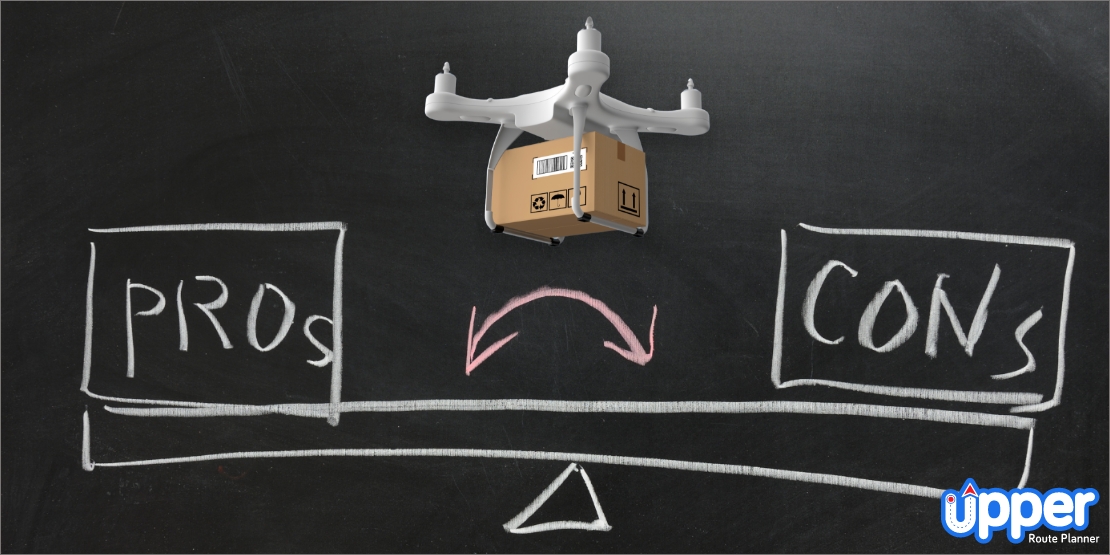
Pros
If delivery drones didn’t have any advantages over traditional delivery systems, then they would be kicked to the curb. However, this is not the case as drones offer some legitimate edges over traditional methods of delivery.
1. Contact-free delivery
Contactless delivery was in all the rage during the pandemic where social distancing and quarantines were enforced. In this scenario, a drone could very literally be a lifesaver for those stuck at home and those that deliver packages.
A drone can bypass all contact occurrences when in transit so that only the receiver and sender are the ones that interact with the package ensuring safety for both parties. Drones can also be easily sanitized and reused almost instantly. This is why you see such high usage of drones in medical deliveries.
2. Avoids common obstacles
A drone doesn’t get stuck in traffic! Isn’t that terrific? That alone is reason enough for many people to want to abandon traditional delivery methods. Since drone operations are conducted exclusively in the air they don’t have to deal with most obstacles faced during deliveries.
Obstacles such as bad roads can also lead to goods being damaged during transit. A drone can single handedly deal with most logistical issues that traditional delivery vehicles have to deal with. This makes them both faster and more reliable at the same time.
3. Works better in remote areas
Drones working in rural areas might sound counter-intuitive, but it is actually where using drones makes the most sense. Because of the amount of open land in such areas, it is very easy for a drone to find potential landing sites unlike in cities where it is very tricky to find a spot to land on.
Rural areas are some of the most expensive places for a delivery company to operate in. A typical van might have to deal with bad roads and long routes while a drone can simply fly over them directly to the destination without crashing thanks to features such as collision avoidance.
Since Rural communities are relatively detached from common infrastructures such as hospitals or supermarkets, they can really take advantage of drone deliveries. They can also call on drones in case of an emergency where traditional help would take hours to arrive.
4. Zero carbon emissions
A big proponent of drone delivery is the fact that it creates zero emissions while in operation. While this is indeed good news for deliveries to remote locations, it might not be the case for other sorts of deliveries.
This is still great news when you consider that almost all other logistical vehicles are gas operated. In this scenario, having an electric drone can cut down on emissions by a considerable amount.
Cons
No product can be without flaws, and drones come with their own set of flaws which can be deal breakers for anyone looking to start a drone delivery business. These drawbacks are mainly caused by the nature of drones by design.
1. People find drones unsettling
You know that a business isn’t worth investing in if people find your product off putting or scary unless you’re selling horror stories of course. Most people don’t like the sound of drones flying overhead as it makes them anxious and very aware of the drone’s presence.
Anything with a propeller is going to be inherently loud as the tips of these propellers cause massive disturbance to the air creating that droning sound. While there are ways to mitigate the noise caused by propellers they severely affect the drone’s performance and efficiency.
While drones crashing out of the sky isn’t a common occurrence, it is still enough for people to not feel safe around drones. There have also been cases of drone crashes resulting in massive wildfires. Such an accident can not only cause huge liabilities to fall on you but also might cause grave injuries.
2. High charging times
Deploying a drone is as instant as it gets however charging a drone is one of the biggest deal breakers for anyone looking to conduct drone deliveries. Traditional delivery modes can be refueled in mere seconds though charging a drone takes hours/
With batteries, it is always a trade between faster charging times or greater battery life. In order to curb this issue, the use of multiple batteries is suggested, though this can not only increase costs but also take a toll on the drone’s motors if operated continuously.
3. High cost of operation
Drones are in no way cost-effective. Sure consumer drones might be cheap enough for an individual to purchase, but commercial drones are far more expensive as they need bigger batteries and stronger motors.
You will also have to hire human pilots in order to complete deliveries should anything go wrong with the drone’s navigation. These drone operators need their own set of licenses to operate the drone and thus will cost a lot more to hire when compared to regular delivery drivers.
Pair the cost of pilots with the cost of automatic drones and their docking stations to see the true cost of running a commercial drone delivery service. This is one reason why many delivery companies refrain from conducting drone delivery operations.
4. Reliability concerns
Despite a drone’s ability to detect obstacles, concerns have been raised regarding the reliability at which it can avoid obstacles. Since drones have not been successfully tested on a large scale, they still leave room for doubt.
We are a long way from having autonomous drones. Most drones that you see are either automatic drones that follow a predetermined flight path or manual drones operated with remote control within the visual line of sight.
Much like any other aircraft, drones can also cause a lot of damage if they were to fly into a bunch of power lines. Drone companies try their best to collect more drone data to study and refine drones to be better at package delivery.
Alternative Solutions to Drone Delivery
With Regular drones having their set of drawbacks, people would obviously look for alternatives though in the case of drones there aren’t many new alternatives. The alternatives are in some aspects superior to drones and have existed for longer than drones.
1. Hydrogen fuel drones
A UAV does not have to be run by batteries. They can also use traditional fuels such as Diesel or Avgas and some newer power sources such as hydrogen. These alternative fuels allow for more drone delivery work to be done as they provide both extra range and payload capacity.
Hydrogen fuel drones are already getting some traction in the drone market despite only a handful of companies manufacturing hydrogen fuel cell drones. Other drones powered by diesel fuel are also on the horizon as it pollutes less than Avgas.
2. Optimized traditional transportation
Drone delivery isn’t really necessary if you could make the current delivery process faster. Current delivery vehicles are the best at reducing costs and conducting more deliveries at once. This is why despite prime air service being developed amazon still invests in making their current delivery system optimized.
Any drone delivery operation is more expensive when compared to current delivery processes. Though with optimization even the price of current systems can be brought down. Businesses understand this and thus choose to go with the traditional forms of cargo delivery over drones.
In order to optimize any delivery operation a company needs the right optimization software that can accommodate its needs and expectations. Whether you are delivering medical supplies or food, your delivery van needs optimized routes.
Perform Unlimited Multi-stop Deliveries Using Upper
Having your packages delivered faster while cutting down on costs is what some would call a dream; however, this dream has been brought to life by Upper! As a route planning software, Upper helps you create the most optimized routes within minutes with just one click.
With the most optimized routes in your possession, you have the power to accommodate more deliveries on the same day! This means that you can save time and make more money all thanks to the wonderful route-planning abilities of Upper!
Uncertainty is a fear of the past when you have Upper to schedule stops in advance so that you can be stress-free. Our clients have saved hours worth of planning and worrying by simply using Upper to make their route-planning process easier than making a sandwich.
Level Up Your Delivery Process with Upper
Never worry about delayed deliveries ever again! Plan, and optimize routes faster than ever with Upper! Switch to an automated delivery process now.
FAQs
You can start a drone delivery service by simply following these 5 steps.
- Understand the local market
- Get the relevant licenses and permits to operate your drone
- Invest in drones that can work automatically and carry big packages
- Create a docking station for your drones to make more deliveries.
- Market your business to potential customers.
The average speed of delivery drones is 30-50 mph. The average drone speed varies depending on the model. Drones such as the amazon prime air drones can fly fast at 50mph.
Delivery drones are usually limited to operating within a 10-mile radius. This is why they can only serve the areas near fulfillment centers.
Future Prospects for Drone Deliveries
A drone delivery system might sound like the perfect business model until you dive deeper into all the drawbacks. Any drone company would very gladly sell you a drone but it is up to you to make it a profitable venture.
Any drone company in the drone industry would prefer to sell small drones as drone laws are easier on them. When they step into the business of air carriers they are going to face the same regulatory hurdles as manned aircraft.
Most issues that arise in this industry are because of the way that drones work and the federal government regulating drones. Unless drones that fly autonomously become the norm the future for drone delivery operations doesn’t look too bright.
What does look bright is the future of companies that rely on Upper to optimize their package delivery routes. This is because using Upper is a surefire way to get the most out of your delivery rounds.
